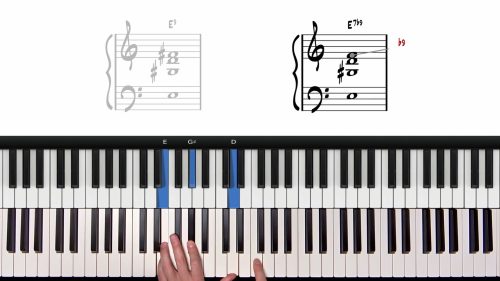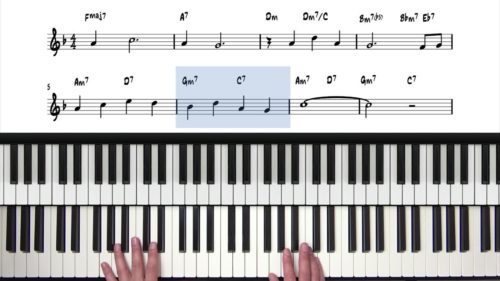Grace Notes & Melodic Embellishments
Welcome to the 2nd lesson in our exploration of the jazz standard “In a Sentimental Mood” for beginner jazz piano players. In the previous lesson, we covered the first A section of the tune, which spans from bar 1 to bar 8. This lesson builds on that foundation as we introduce the 2nd A section, which extends from bar 9 to bar 16.
“In A Sentimental Mood” – AABA Form
“In a Sentimental Mood” follows the classic AABA form, a structure you’ll encounter frequently in jazz and when playing from the lead sheets. This form consists of 3 A sections, which are often nearly identical, followed by a contrasting B section, or bridge. Understanding the form is crucial as it allows us to memorise and internalise the tune’s structure.
Left Hand Voicings: Adding Interest
As we revisit the A section in this lesson, we introduce a technique to add more interest to our left-hand chord voicings. In the first A section, we focused on playing the basic voicings: D- to D-maj7 to D-7 and finally to D-6. We now add a subtle variation by staggering the notes to create a more dynamic and rhythmic left hand accompaniment.
Instead of playing the notes of each chord in unison, we can subdivide the rhythm and ‘stagger’ the notes in our left hand. We can do this by counting 1 & 2 & 3 & 4 & etc… whilst playing the individual notes of each chord to create a rhythmic pattern and descending bass line in our left hand.
This approach can be applied to the D- line cliché section and also the G- line cliché section.
Grace Notes & Melodic Embellishments
Another way to add variety to the repeating A sections is by adding grace notes and other melodic embellishments. In essence, a grace note is a quick, ornamental note played just before a main note, creating a sense of tension and release within the melody. These notes are not counted as part of the beat but instead serve as a decorative lead-in to the principal note.
For instance, as we play the pickup bar leading into the A section, we can grace into the melody note (A) by quickly playing an G# or Ab just before it. We cover many more examples of grace notes in the performances and demonstration sections.
By incorporating grace notes, we can mimic and emulate the vocal inflections and expressiveness of a singer, giving our piano playing a more lyrical quality.
Practice Tips
-
Left-Hand Rhythm: Stagger the notes in your left-hand chords to create a more interesting rhythmic pattern in our accompaniment
-
Use Grace Notes Sparingly: Add grace notes to enhance the melody, but be careful not to overdo it. The goal is not to overwhelm the melody, but simply decorate it with subtle embellishments.
-
Listen to Recordings: Pay attention to how different musicians interpret and embellish the melody of “In a Sentimental Mood.” This can inspire you to develop your own style.
-
Repetition with Variation: Since the AABA form repeats, aim to introduce slight variations each time the A section returns. This keeps the listener engaged and showcases your creativity.
-
Slow Practice: Practice slowly to internalise the rhythmic variations and melodic embellishments before gradually increasing the tempo.






